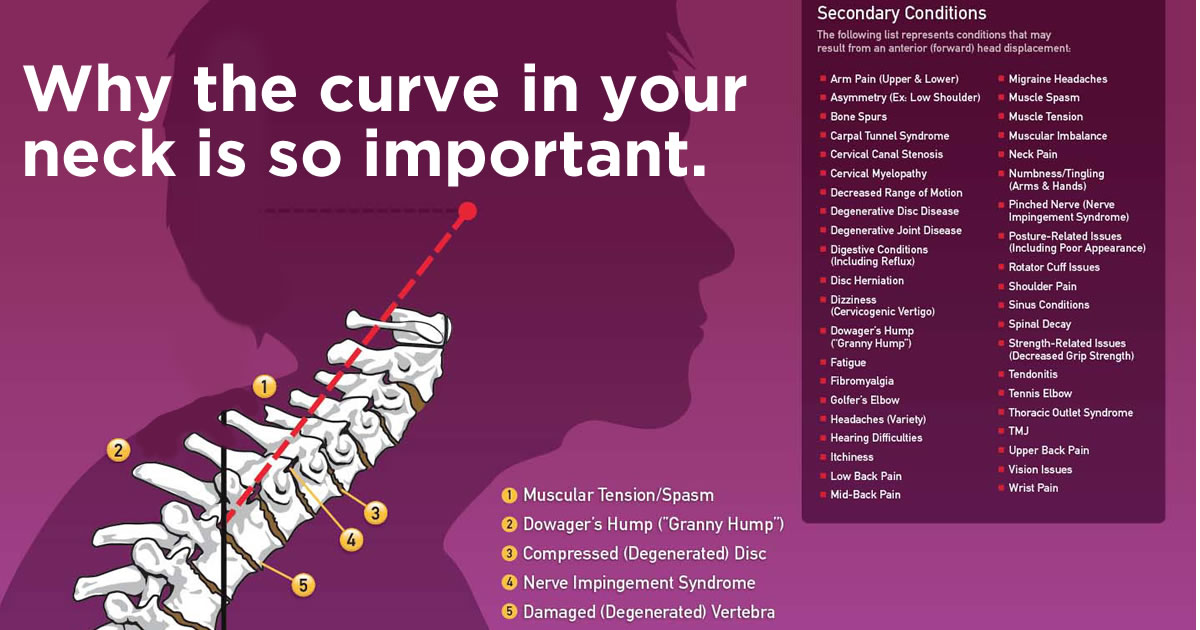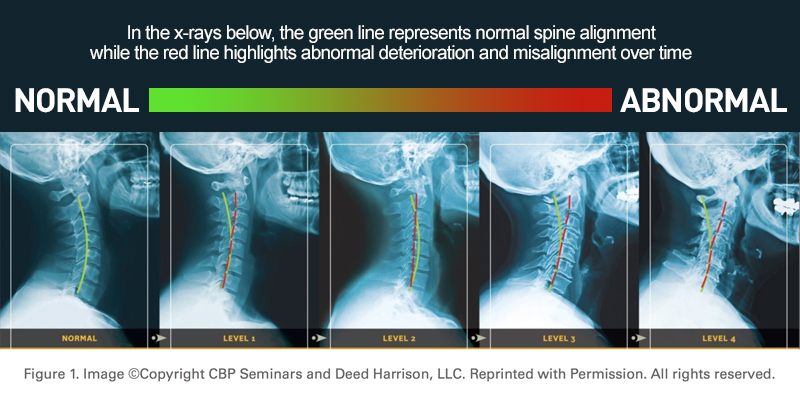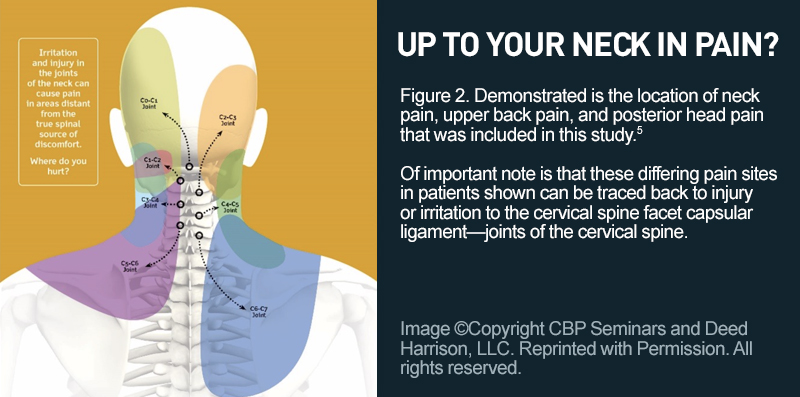Let me be blunt: Abnormal neck curvatures are 18 X's more common in chronic neck pain subjects compared to those with no pain.
If you're a patient of mine, then you should have an idea of what an Xray of your neck looks like.
80% or more of my patients come to find out that they have a partial, complete and in some cases reversal of the normal curvature of the neck.
And many of you have already started the process of correcting this problem and I hope that you continue to make improvements.
That said, this article is more for people who don't know what they don't know!
What is a normal healthy neck curve?
Figure 1 below demonstrates a normal healthy curvature of the neck starting from the left and unhealthy curvatures of the neck as you proceed to the right. From the left, this person would be expected to have little to no neck related disorders.
Then the progressive loss of curve is shown in the consecutive images to the right where you can see the development of spinal arthritis and disc disease in different patients over time is shown (Levels 1- 4).
This figure is not based on opinion, but results from the scientific literature including prospective studies on individuals over time.
If you're reading this and have no clue what your xray looks like, then I'd highly recommend that you 1) schedule an appointment with our office to figure it out or 2) look up a corrective care chiropractor to help you determine what level you're at.
If you do know what your neck curvature is, then keep reading to gain a greater understanding of the importance of continuing to work on correcting it.
The Link Between Neck Pain, Arthritis and Loss of the Cervical Curve
Neck pain is one of the most common symptoms people experience today. Certainly, well over 80% of my patients suffer from some form of headache, neck pain, shoulder blade/trapezius pain and or numbness and tingling that radiates into their hands.
It's also not surprising when someone comes to see me with these symptoms we find several abnormalities when it comes to physical examination, digital posture analysis, functional movement and of course X-Ray.
A normal neck presents with a C shaped curve of approximately 43 degrees measured from the second bone in your neck (C2) to the seventh bone (C7). Without this normal curve, most often the balance of the weight of the head is tilted forward and creates increased wear and tear on the discs and the bones themselves.
Literally… the bones of your neck will age faster than normal.
This eventually leads to bony spurs that we then call spine arthritis. These changes also lead to decreased mobility of the cervical spine, increased stiffness and pain.
Although there is an abundance of scientific research showing a strong link between loss of the proper lateral curvature of the neck, we know that some cases are “clinically silent”. Just because it doesn't hurt, doesn't mean there's not a problem!
In other words, not everyone who has degeneration of the cervical spine (neck) is going to have pain.
And likewise, not everyone who has pain is going to have degeneration. It's what makes imaging (X-ray, MRI, CT, etc) dicey as far as being able to pinpoint an exact reason that someone has pain. Unfortunately, many of you who have been living on the MEDICAL MERRY-GO-ROUND understand this all too well.
While none of this could be considered “new” information, it is information that is almost totally ignored by the medical community. It's another one of those areas where the gap between the way that physicians are treating patients in their clinics, and the discoveries that researchers are making in their labs is more like the GRAND CANYON.
That said, who do you know that doesn't have pain in their neck, traps, mid back or between the shoulder blades?
In a breakthrough spine study, McAviney and colleagues looked at 277 subjects who were categorized as either healthy controls (99 subjects from a screening) or those who were categorized as chronic neck pain patients (178 from those seeking treatment).
Figure 2 below demonstrates the location of neck pain, upper back pain, and posterior head pain that was included in this study. Of important note in Figure 2 is that these differing pain sites in patients can be traced in most cases to injury or irritation to the cervical spine facet capsular ligament—joints of the cervical spine.
Pay attention to the areas colored below. If you have pain in these areas, it's highly likely that you have a major subluxation or misalignment in your spine contributing to problems.
Several key findings were noted in this important research project:
- In children aged nine years and up, McAviney et al found that reduced cervical lordosis was correlated to the presence of sub-acute and chronic cervico-genic pain. This finding was not age or gender dependent strengthening these findings.
- Statistically, persons whose cervical spine curves were above 20° were 2 x as likely to be in the normal subject group; conversely those with curves less than 20° were TWICE as LIKELY to be in the chronic neck pain group.
- Furthermore subjects with a straightened or reversed cervical curvatures were 18 TIMES more likely to be in the chronic neck pain group as compared to the non-pain group.
The 20° cervical curvature amount was identified to be the best statistical predictor of which subjects had chronic neck pain vs. who was without pain. This 20° curvature was found to have good sensitivity and good specificity in discriminating between subject groups.” said Doctor Deed Harrison, a senior author of the study.
Normal is Necessary
The whole reason your body requires a “normal” neck curve is to allow for normal joint motion which then allows for normal spinal cord function — joints can only move correctly when normal structure is present and the spinal cord will only function correctly when the joints are mobile.
In an age of relativism, this can be a bitter pill to swallow — particularly if you do not have any overt symptoms or pain. In other words, many would have you believe that your “normal” is different than my “normal”. Not true. Back in a 1959 study done by Borden, Hechtman, and Gershon-Cohen — all M.D.'s (The Normal Cervical Lordosis), began to answer this question of what makes up a normal cervical curve. And although the measuring method was dramatically different than today's methods, their picture of what constitutes “normal” was just about identical to what would pass for normal today. Although there have been numerous studies on this topic since, a 2005 study in JMPT (a medical journal) sums it up nicely in a study called Determining the Relationship Between Cervical Lordosis and Neck Complaints. Listen to what the authors wrote after sorting patients into two main groups — those with neck problems and those without.
“We found a statistically significant association between cervical pain and lordosis less than 20 degrees and a “clinically normal” range for cervical lordosis of 31 degrees to 40 degrees. Patients with lordosis of 20 degrees or less were more likely to have cervicogenic symptoms [symptoms arising from the neck]. The odds that a patient with cervical pain had a lordosis of 0 degrees or less was 18 times greater than for a patient with a noncervical complaint.”
Abnormal Curvature Begins with Abnormal Posture
SUBLUXATION is defined simply as bones (usually vertebrate) that lose their normal alignment or motion in relationship to each other. Study after study after study is verifying the devastating effects of poor posture / postural deformities on human health.
If you Google “effects of poor posture research studies” you will find studies linking postural abnormalities to everything but the kitchen sink. Some of those specifically mentioned in the peer-reviewed research included things as diverse as fear, sadness, emotional instability, mental acuity, mood, energy levels, back pain, coordination, constipation, and even certain types of cancer.
There is even research linking poor posture to shorter life span.
What I really want you to notice here is how few of these problems that were mentioned have anything whatsoever to do with pain. We'll get to why this is shortly. Suffice it to say that FHP (Forward Head Posture) along with trunk flexion (THE POSTURE OF AGE or THE ELDERLY) have tons of peer-review showing how detrimental they are to human health.
Adjustments Alone Can't Fix It
Don't get me wrong; adjustments are extremely powerful. The problem is… there are other factors that need to be addressed when it comes to tissue elasticity, viscosity, plasticity and strength.
However, every time we make an adjustment we are affecting the health of all viscera in the body.
Every adjustment affects the hypothalamus via layer 7 of the spinal cord. And get this….the spine is the only direct influence on the hypothalamus in the entire body! A bad spine negatively and directly affects all stress hormones in the body. This is torture for the human experience if it becomes chronic!
Although you don’t have to know everything about layer 7 of the spinal cord, just know that altered mechanics or movement from a bone in your spine travels to layer 7 and connects to it. This then goes to parts of your spinal column that control our fight/flight response (sympathetic chain ganglia) and affects a host of things there as well as up the cord into the upper brain centers for the body to process.
When we make an adjustment it is clear that the brain will immediately begin to inhibit (stop) the sympathetic dominant state and start into a parasympathetic state. You may have heard this before but I can guarantee you don’t fully know what this means for human health. It has to do with the hypothalamus and the balance of autonomic activity.
Without getting too technical, I can tell you that stress hormones begin to be reduced which sets off a cascade of positive effects in the body.
We know that the “fight or flight” behavior physiology is inhibited and the body will go from alarm & defense to growth & repair.
This is the scientific groundwork to why the latest and best studies on the influence of a chiropractic adjustment show this:
- Normalizing Blood Pressure
- Mood and Attention Improvement
- Blood Glucose efficiency– decreases insulin resistance
- Improvements and/or Reversal of neurodegenerative brain physiology (HUGE!)
- Epigenetic Changes – this changes fertility and short & long term offspring physiology
- Increase ATP – which is a “game-changer” for many reasons
- Telomere shortening – one of GREATEST “anti-aging” strategies in health today!
- Heart Disease – #1 contributor to heart disease in men and women is increased sustained sympathetic tone
- Immune System – Radically affects the immune system. Better than any marketable strategy medicine has to offer
Did I Mention Brain Changes?
- One study noted the changes made in brain patterns and activity was more in one session than multiple weeks of standard psychological treatment made to brain!(You should know that brain-based neurophysiologists get their mind blown when they get to see the power of an adjustment on the brain!)
- Chiropractic was also shown to improve muscle strength, stability, and fatigue more in one session than 3 weeks of weight training! (Mind-Blowing!!)
But… as amazing and beneficial as an adjustment can be… it alone will not correct the curve in your neck!
YOU MUST HAVE ACCURATE AND REPEATABLE METHODS OF ANALYSIS
It's not rocket science.
There are essentially two different aspects to this bullet point. Visual Postural Analysis and / or X-rays. The more accurate of the two will almost always be X-ray.
This is simple to check, takes all of about 10 seconds to do, and in most cases, will tell me exactly where I need to focus my attention — particularly with Tissue Remodeling.
Consequences of Abnormal Neck Curvature
Whether you have symptoms or not… it's inevitable. Those who have an abnormal neck curve will experience:
- Loss of range of motion and flexibility (ie the ability to turn/rotate or flex your head and neck)
- Acute and Chronic Neck Pain including headaches, muscle spasms, “cricks” in the neck, fatigue and irritability
- Neurological Issues including numbness, tingling, weakness, radiating pain or shooting pain
- Degeneration or accelerated aging of the bones of the spine and disc disease
Do you have a neck?
If so, then this is valuable information for you and the people you care about.
Don't hesitate to forward it on to someone you know that could benefit.
In fact the easiest and most effective way of reaching the people you love and care about is to share it on Facebook!





